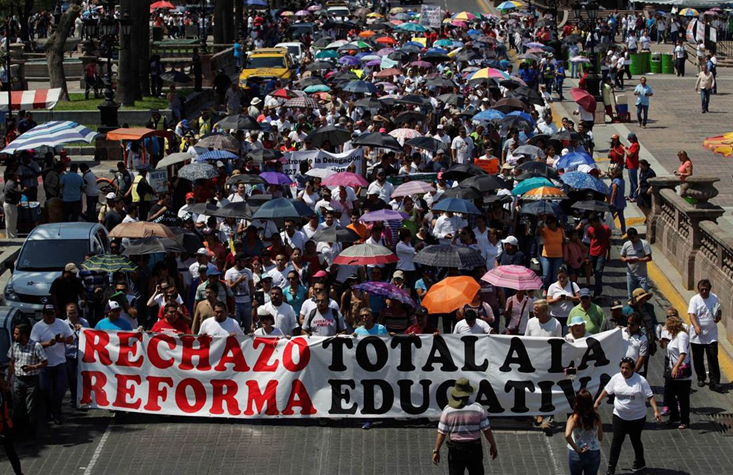 Miembros del sindicato de docentes (CNTE) asedian el congreso mexicano para presionar a los legisladores para que excluyan las evaluaciones de los procesos de entrada y promoción de docents
Miembros del sindicato de docentes (CNTE) asedian el congreso mexicano para presionar a los legisladores para que excluyan las evaluaciones de los procesos de entrada y promoción de docents
Rafael de Hoyos works with the Center for Economic Research (ITAM) in Mexico while on leave from the World Bank’s Education team
Can you imagine boarding a plane whose pilot bought his or her piloting license? Or having a surgery performed by a doctor that inherited his medical diploma from her auntie? Or purchasing a house that was built by an architect who got her degree simply because she was good friends of the leader of the union of architects? For years (prior to 2013) something similar happened in Mexico. Millions of parents sent their children to schools where some, a few or most teachers bought, inherited or got their teacher positions through a political, social, or family connection.
Hiring teachers in such a discretionary manner, favoring political or family connections over teacher quality, has a profound and long-lasting negative impact on student learning outcomes. In 2013 a reform mandating merit-based selection and promotion of teachers was passed in Mexico. The bill introduced a mandatory evaluation for all incumbent teachers with consequences linked with evaluation results. These changes were implemented through the creation of an autonomous evaluation institute (INEE for its acronym in Spanish) responsible for designing the evaluation instruments and supervising their implementation.
In 2014, for the first time in Mexico, all incoming teachers were selected via a content-knowledge evaluation and subject to a two-year probationary period. After the probationary period, teachers were evaluated on content knowledge as well as pedagogical planning and those who did not meet the minimum standards did not get a permanent contract. For teachers with a permanent contract prior to 2014, the evaluation results determined either economic incentives (for good performers) or mandatory training and a follow up evaluation after one year (for poor performers). Teachers with three consecutive evaluation results below the minimum standard were removed from teaching positions and reassigned to administrative tasks.
In many ways, the design of the 2013 reform introduced good international practices, such as rewarding performance and helping teachers improve, while tackling, head-on the practice of buying / selling or inheriting teaching positions. However, the reform had important omissions and failed to mitigate significant risks, which paved the way for its eventual reversal. The following are, from my point of view, the most important drawbacks of the design and its implementation:
- No consultation and a poor communication strategy. The Reform was not the outcome of a national consultation to ensure buy-in among public-school teachers in Mexico. The negative effects of the lack of consultation were compounded by a poor communication strategy that failed to change, let alone pre-empt, the rhetoric on the reform being about firing teachers.
- Limited implementation capacity. Going from no evaluation to evaluating 1.5 million teachers involved significant implementation challenges, which were not adequately addressed and diminished the credibility of the evaluation.
- Linking in-service evaluation with job stability. This was, perhaps, the most serious shortcoming of the Reform’s design. It provided the detractors of the Reform with the opportunity to construe, in a very effective way, the narrative that the Reform’s main objective was that of punishing and firing teachers.

The lack of consultation together with a poor communication strategy meant that teachers had little information on the main objectives and instruments of the Reform. For instance, the first in-service teacher evaluation took place in 2015 and evaluated more than 130,000 teachers. The evaluation was computer-based, and many locations lacked the minimum conditions: functioning computers, well-trained facilitators, clear instructions, among others. Under these conditions, the evaluations could take as much as 8 hours. The evaluation institute, INEE, improved the evaluation instrument in 2016 but the damage to the credibility of the evaluation was already done.
Limited implementation capacity also had a negative impact on teacher training. In theory, the results of the evaluation for in-service teachers were supposed to guide the supply of teacher trainings offered by the Ministry of Education. In practice, the supply of training was not as “elastic” as originally thought, so it remained practically unchanged. The mandatory training for teachers with evaluation results below the minimum standard was perceived as irrelevant, contributing further to the narrative of a reform designed with the sole purpose of punishing teachers.
Linking the results of the in-service teacher evaluation to teachers’ tenure was, as they say in American Football, unnecessary roughness. The teachers’ union, understandably, was against linking the evaluation results with “permanencia” or teachers’ tenure. The discussion between the union leader and the then Minister of Education around this issue became almost the sole focus of the media attention which also contributed to the teacher-punishing narrative put forward by reform opponents. The costs of this decision were high and the “benefits” almost non-existent since less than 1 percent of the teachers evaluated between 2015 and 2018 were either fired (those that entered post-2014) or reassigned from teaching positions to administrative positions (those with tenure pre-2014).
With a narrative of “Reform equals punishing teachers” well embedded in society, attacking the reform became a campaign promise of the new government. On May of 2019 the Congress approved a new constitutional reform removing mandatory evaluations for selecting and promoting teachers and making INEE a decentralized agency dependent on the Ministry of Education, with no autonomy. This opened the door to reverting to the pre-2013 low equilibrium situation. All graduates from teacher colleges have now been promised teaching jobs, promotions will no longer be based on objective and transparent criteria, and all teachers who lost their positions under the 2013 Reform will be reinstated.
The Mexican experience exemplifies the perils of adopting a shock therapy approach rather than gradualism. Shock therapy leaves no space for mistakes or drawbacks and demands a robust consultation process, an effective communication strategy and proven implementation capacity. When shock therapy fails, it can lead to unwarranted policy reversals. Given this, it might be better to go gradual, as with Chile, which opted for a gradual reform approach starting with a voluntary teacher evaluation, making it mandatory only after several years of learning from implementation. Chile’s reforms have been sustained over decades, and its students are learning significantly more than those in Mexico where the interests of different groups still struggle to align around the rights to learn of children and youth.
Note: The World Bank and the author of this text were not involved in the design of the 2013 education reform in Mexico


Join the Conversation